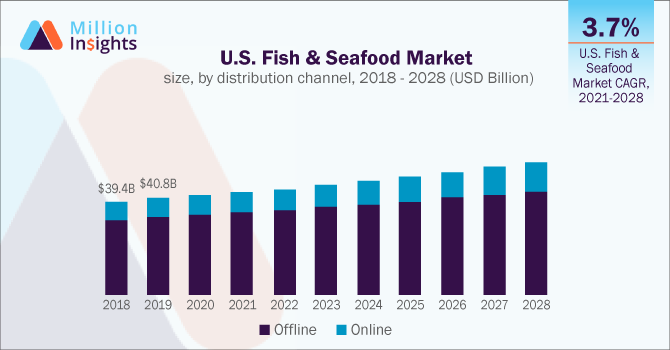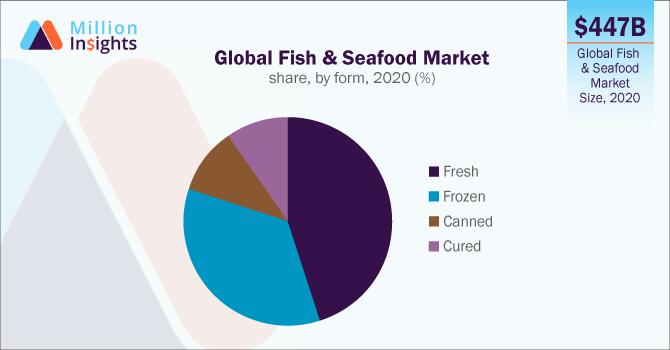The global fish and seafood market size was valued at USD 446.6 billion in 2020 and is expected to expand at a compound annual growth rate (CAGR) of 3.3% from 2021 to 2028. The market growth can be credited to the growing consumption of fish and seafood products in developed and developing nations. Moreover, the growing awareness regarding the health benefits, such as reducing the risk of chronic diseases and balancing hormone levels, is expected to accelerate the market growth over the forecast period. Additionally, fish and seafood products have gained significant traction as sources of high amounts of nutritional components like minerals, high-quality protein, healthful fatty acids, and crucial vitamins to the human diet, which, in turn, is driving the market.

The growing contract farming and various government policies regarding the production of fish and seafood across the globe are boosting the market growth. Moreover, rising per capita consumption and the growing consumer expenditure on fish and seafood products are some of the key factors behind the growth of this industry. However, changing climatic conditions like the acidity of water of oceans, oxygen level, and temperature could affect the cultivation of fish and seafood products, which may hinder the market growth.
The growing trend of aquaculture production of various fish and seafood products is observed in these years, which may accelerate the production of fish and seafood products across the globe. However, consumers’ food consumption pattern is shifting from home-cooked food to ready-to-eat food, which has been restraining the market growth.
The pandemic-induced lockdown across various regions had disturbed transportation and suspended the supply of fish and seafood products for a short duration. The supply chain is susceptible to being disrupted or stopped by the restrictions imposed due to the COVID-19 pandemic. In aquaculture, the unsold production of fish and seafood has resulted in increasing levels of live fish stocks. Furthermore, it has created higher costs for feeding and risks of fish mortalities.
The offline channel held the largest revenue share of more than 80.0% in 2020. The offline segment includes hypermarkets and supermarkets, convenience stores, specialty stores, and retail stores. Consumers are preferring offline channels for purchasing goods, groceries, and fish food products, where they can physically verify the product quality. Moreover, easy product access is likely to drive the segment.
The online segment is expected to register the fastest CAGR of 4.3% from 2021 to 2028. An upsurge in product sales through various company-owned websites and e-commerce platforms is expected to propel the segment growth over the forecast period. Moreover, the increasing usage of the internet and smartphones is accelerating the growth of this segment.
The fresh fish segment held the largest share of over 45.0% in 2020. The consumption of fresh fish has been driven by the increasing production and advancement in the cold chain, shipping, and distribution channel across the globe. Moreover, the growing demand for protein-rich diets instead of high-calorie food products from consumers is accelerating the growth of this segment.
The processed fish and seafood segment is expected to expand at the fastest CAGR of 4.1% from 2021 to 2028. The rising production of value-added processed food products is boosting the demand for this segment in developed economies. Moreover, the growing health consciousness among the consumers has increased the demand for nutritious processed fish and seafood products as the consumption of fish products will reduce the risk of chronic diseases, which, in turn, is accelerating the market growth.
The fresh segment held the largest share of more than 40.0% in 2020. Increased production and consumption of fresh fish and seafood as they form healthy alternatives to poor-quality food is propelling the market growth. Additionally, the rising consumers’ inclination towards eating protein-rich food and other nutrients like omega-3 fatty acids is significantly accelerating the demand for fresh fish and seafood products.

The cured segment is anticipated to exhibit the fastest growth rate of 4.6% from 2021 to 2028. Continuously changing lifestyles, coupled with the busy life schedules of consumers, are expected to accelerate the demand for cured products. Moreover, increasing preservation of fish and seafood to prevent excessive dehydration during storage and contamination with harmful bacteria is propelling the growth of this segment.
Asia Pacific captured the largest share of over 60.0% in 2020. The rising demand for protein-rich food products and growing awareness regarding the health benefits of consuming fish and seafood products are expected to accelerate the regional market growth. Moreover, the increasing consumption of fish and seafood products in developing countries like China, India, and Indonesia owing to consumers’ inclination towards a healthy lifestyle, changing dietary habits, and the rising disposable income will further boost the regional market growth.
Europe is expected to register the fastest CAGR of 4.1% from 2021 to 2028. The growing awareness regarding the health benefits and rising demand for premium quality seafood products will boost the market growth over the forecast period in this region. Moreover, the increasing health concerns about premature skin aging and bone health and the high prevalence of cardiovascular diseases (CVDs) are propelling the demand for fish products in this region.
The market is fragmented with the presence of various established market players and suppliers of fish and seafood across the globe, coupled with numerous domestic players. Various manufacturers and suppliers are focusing on the development of innovative packaging, logistic development, and strengthening of the distribution channel to grow their business across the globe. Some prominent players in the global fish and seafood market include: -
|
Report Attribute |
Details |
|
Market size value in 2021 |
USD 459.1 billion |
|
Revenue forecast in 2028 |
USD 576.0 billion |
|
Growth Rate |
CAGR of 3.3% from 2021 to 2028 |
|
Base year for estimation |
2020 |
|
Historical data |
2017 - 2019 |
|
Forecast period |
2021 - 2028 |
|
Quantitative units |
Revenue in USD million/billion and CAGR from 2021 to 2028 |
|
Report coverage |
Revenue forecast, company ranking, competitive landscape, growth factors, and trends |
|
Segments covered |
Product; form; distribution channel; region |
|
Regional scope |
North America; Europe; Asia Pacific; Central & South America; Middle East & Africa |
|
Country scope |
U.S.; Germany; U.K.; France; China; India; Indonesia; Brazil; South Africa |
|
Key companies profiled |
Mowi; Charoen Pokphand PCL; Maruha Nichiro Corporation; Thai Union Group PCL; Cermaq Group AS; Trident Seafoods; Tassal Group Ltd.; Huon Aqua; Stolt Sea Farm; True World Foods; Acme Smoked Fish Corporation; Austevoll Seafood ASA; High Liner Foods Inc. |
|
Customization scope |
Free report customization (equivalent up to 8 analysts’ working days) with purchase. Addition or alteration to country, regional & segment scope. |
This report forecasts revenue growth at the global, regional, and country levels and provides an analysis of the latest industry trends and opportunities in each of the sub-segments from 2017 to 2028. For the purpose of this study, Million Insights has segmented the global fish and seafood market report on the basis of product, form, distribution channel, and region:
Sign up today.
Call us at +1-408-610-2300 to speak with a
representative.